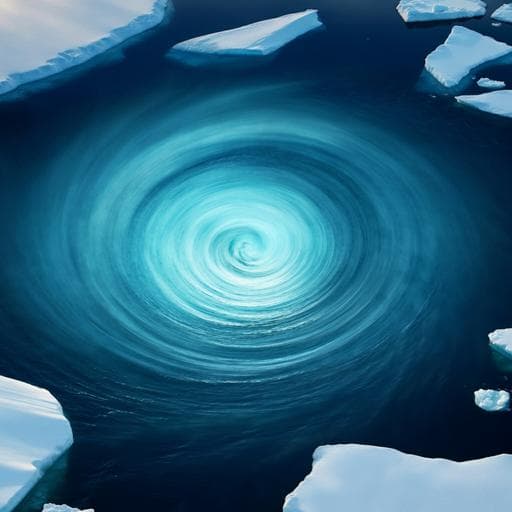
Earth Sciences
Future sea ice weakening amplifies wind-driven trends in surface stress and Arctic Ocean spin-up
M. Muilwijk, T. Hattermann, et al.
Discover how Arctic sea ice decline impacts ocean dynamics! Researchers Morven Muilwijk, Tore Hattermann, Torge Martin, and Mats A. Granskog reveal that future ocean surface stress is set to increase, enhancing momentum transfer to the ocean and affecting ecosystems and circulation. Don't miss the insights derived from cutting-edge climate models!
~3 min • Beginner • English
Introduction
The Arctic is warming more than four times faster than the global average and has experienced substantial sea ice loss, thinning, and changes in extent. Sea ice mediates the transfer of atmospheric momentum to the ocean and thus affects surface currents, vertical mixing, stratification, nutrient supply, and ecosystems. As the ice pack thins and becomes less compact, the fraction of wind stress dissipated internally within sea ice changes, potentially altering how much momentum reaches the ocean. Although winds are projected to strengthen and sea ice to decline further, the combined impact on future Arctic Ocean surface stress and circulation has remained uncertain. This study addresses how Arctic Ocean surface stress and upper-ocean velocity will respond to declining sea ice concentration and thickness alongside changing winds under continued global warming, and how these responses vary seasonally across the Arctic.
Literature Review
Prior work suggested that retreating sea ice could energize the Arctic Ocean and enhance turbulent mixing, with observations already indicating increases. The ice–ocean stress governor mechanism shows that internal ice stress can limit ocean response to wind forcing, implying that thinning, less compact ice could weaken this governor. Studies have documented projected increases in Arctic wind speeds and cyclone activity, and identified relationships between surface stress and sea ice concentration, including potential stress maxima at intermediate concentrations. Earlier modeling has highlighted the roles of variable form drag and roughness at air-ice and ice-ocean interfaces, but parameterization uncertainties remain substantial, and even the sign of stress changes can be sensitive to drag formulations. Overall, literature indicates that changing sea ice state and winds jointly modulate momentum transfer, but comprehensive projections of future Arctic-wide surface stress and ocean spin-up across an ensemble of climate models were lacking.
Methodology
The study analyzes monthly output from 16 CMIP6 models under the high-emissions scenario ssp585 for 2015–2100, focusing on the Arctic Ocean (central basin and shelves bounded by Fram Strait, Barents Sea Opening, Nares Strait, and Bering Strait). Variables include surface wind speed (sfcwind), sea ice concentration (siconc), thickness (sithick/sivol), ocean surface stress (tauuo, tauvo), atmospheric wind stress (tauu, tauv), ice velocity (siu, siv), and ocean velocity (uo, vo). Five models provide stresses at ice top/bottom interfaces; internal ice stress is archived only for NorESM2-MM, which is used as a detailed case study to decompose the momentum budget. Seasonal means are defined as winter (Jan–Mar), summer (Jun–Aug), and fall (Sep–Nov). Trends in ocean stress and wind speed are computed mainly for 2015–2060 (to capture transient changes before plateauing). Spatial averages and linear trends are calculated on native grids; uncertainties use standard errors, and trends are assessed at the 95% confidence level.
Decomposition: In partially ice-covered regions, total ocean surface stress τ is computed as τ = (1 − A)τ_ao + Aτ_io, where A is sea ice concentration, τ_ao is atmosphere–ocean stress over open water, and τ_io is ice–ocean stress. For NorESM2-MM, the total Arctic-integrated terms are further decomposed into atmosphere–ice stress and internal ice stress contributions (with ice internal stress acting as a sink of momentum). The atmosphere–ocean stress is split into components attributable to increasing wind speed and increasing open-water area using the model’s bulk formula over open water (Large and Pond-type neutral drag formulation). Additional diagnostics include: Ekman pumping (from curl of τ), liquid freshwater content (FWC) relative to S_ref=34.8, and integrated kinetic energy (to 100 m). A “dampening effect” metric quantifies the percent reduction of total atmospheric stress to ocean surface stress due to sea ice. Analyses of sea ice thickness and speed are performed where data are available (two models lack ice speed fields; GFDL models are excluded from Ekman pumping due to grid issues).
Key Findings
- CMIP6 models consistently project increased Arctic Ocean surface stress in all seasons, with the largest trend in winter: +5.1% per decade; fall also increases: +2.1% per decade (2015–2060). Spatially, trends are positive across the basin, strongest in the Chukchi Sea and Beaufort Gyre.
- Surface winds strengthen Arctic-wide; trends are larger in fall than winter over 2020–2060 (+2.2% vs +1.2% per decade). Despite this, surface stress trends are larger in winter than fall, indicating modulation by changing sea ice conditions.
- Seasonal plateau: In summer and fall, wind speed continues increasing through 2100 while surface stress tends to level off after ~2060, likely due to evolving sea ice concentration leading to sub-optimal conditions for maximizing stress at intermediate ice cover, and multi-model averaging effects.
- Decomposition (NorESM2-MM): Total ocean stress increases in all months. Increased total atmosphere–ocean stress (from both rising winds and expanding open water) is the primary driver. Total ice–ocean stress generally decreases in summer–early winter (due to shrinking ice area), but increases in late winter–spring (Feb–May) because reduced internal ice stress allows more momentum to reach the ocean. In February, increased ice–ocean stress explains ~29% of the total stress trend; in March–April ~50%.
- Sea ice dampening of momentum transfer: All models show a present-day positive dampening effect (atmospheric stress > ocean stress) ranging from 8% to 39%. Under warming, the dampening effect is consistently reduced across models by −2% to −18%; the multimodel mean dampening declines from ~19% to ~10% (−9% absolute) by 2100.
- Seasonal changes: By late century, wind speed annual amplitude increases by ~67% with the peak shifting from October to December. Ocean surface stress amplitude increases by ~46% with the peak shifting from December to February; the amplification in winter is linked to reduced internal ice stress. Sea ice concentration amplitude decreases by ~18% (September minimum from ~37% to ~2%; March maximum from ~91% to ~48%). Internal ice stress seasonal amplitude (NorESM2-MM) decreases by ~30%.
- Sea ice state: Sea ice thickness decreases by ~85% in fall and ~78% in winter by 2100; sea ice speed increases across the Arctic, with a multimodel mean increase of ~30% (noting sampling impacts as ice area declines).
- Ocean response: Surface current speeds increase significantly basin-wide; multimodel mean winter and fall trends are 8.4×10⁻⁵ and 3.3×10⁻⁵ m s⁻¹ per decade, yielding cumulative increases of ~29% (winter) and ~13% (fall) by 2100. The abstract reports overall surface velocity increases of +31–47% by 2100 across models. Vertical mixing (NorESM2-MM diapycnal diffusivity to 100 m) increases by ~74% in fall and ~48% in winter by 2100. Kinetic energy increases across models.
- Beaufort Gyre impacts: Enhanced surface stress strengthens Ekman convergence and contributes to increased freshwater content (FWC rises in all seasons across models). Ekman pumping shows a +33% increase in winter but a −26% trend in fall, consistent with seasonal stress changes. Freshwater increases are primarily driven by increased freshwater fluxes (runoff, precipitation, ice melt, inflows), with enhanced stress helping contain freshwater within the gyre.
Discussion
The study demonstrates that Arctic Ocean surface stress will increase under continued warming due to both stronger winds and a weakening, less extensive ice pack that reduces momentum dissipation within sea ice. The wintertime amplification of surface stress, despite larger wind increases in fall, is explained by declining internal ice stress that facilitates more efficient transfer of atmospheric momentum to the ocean. The resulting spin-up of surface currents, enhanced kinetic energy, and stronger vertical mixing point to a more energetic Arctic Ocean, with significant implications for nutrient supply and primary production, as well as for sea ice melt feedbacks. In the Beaufort Gyre, increased stress enhances Ekman convergence and contributes to growing freshwater content, potentially altering freshwater pathways and influencing North Atlantic circulation. While the overall response is robust across models, the magnitude and partitioning of momentum flux depend on model-specific formulations (e.g., constant vs state-dependent drag, rheology), leading to uncertainties in quantitative projections. Nevertheless, across models, a consistent reduction of the sea ice dampening effect is found, underscoring the central role of changing ice state in future momentum transfer and ocean dynamics.
Conclusion
This work provides a pan-Arctic, multi-model assessment showing that future declines in sea ice area and thickness, together with strengthening winds, will increase ocean surface stress—especially in winter due to reduced internal ice stress—driving an Arctic Ocean spin-up, enhanced vertical mixing, and intensified Beaufort Gyre convergence with increased freshwater storage. Key contributions include a decomposition of stress components (with a NorESM2-MM case study) that clarifies the role of weakened ice internal stress in amplifying wintertime ocean stress, and a robust multi-model indication of a declining dampening effect of sea ice on momentum transfer. Future research should prioritize improved model coupling and parameterizations of air-ice and ice-ocean drag (including form drag and evolving roughness), better representation of sea-ice rheology and internal stress, higher temporal and spatial resolution diagnostics (daily outputs), multi-scenario and multi-member ensembles to assess uncertainty and internal variability, and expanded observations at the atmosphere–ice–ocean interface to constrain parameterizations and validate model projections.
Limitations
- Parameterization uncertainty: All CMIP6 models here use simplified or constant drag formulations for ice–ocean momentum transfer; more advanced, state-dependent form drag parameterizations are not widely employed and remain poorly constrained, affecting both magnitude and even sign of stress changes in some contexts.
- Diagnostic availability: Full momentum budget terms (especially internal ice stress and separate interface stresses) are only available for NorESM2-MM, making detailed decomposition reliant on a single model that overestimates sea ice area; other models lack comparable diagnostics, limiting cross-model attribution.
- Resolution and temporal sampling: Analyses use monthly means at typical ~50 km resolution (except higher-resolution outliers), limiting the representation of mesoscale processes, marginal ice zone dynamics, and day-to-day variability; relationships between stress and ice concentration are less robust than in studies using daily data.
- Scenario and ensemble coverage: Only the high-emissions scenario (ssp585) and one ensemble member per model are analyzed; internal variability and scenario dependence are not fully explored.
- Exclusions and data gaps: Some models lack ice speed fields; GFDL models are excluded from Ekman pumping due to grid/curl issues; internal stress is unavailable outside NorESM2-MM; the plateauing of stress after ~2060 is not examined in depth.
- Causality in Beaufort Gyre responses: While enhanced stress contributes to increased FWC, changes are also driven by freshwater fluxes; the study does not fully resolve the evolving effectiveness of the ice–ocean governor across individual models.
Related Publications
Explore these studies to deepen your understanding of the subject.







